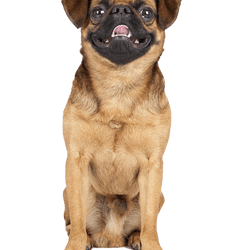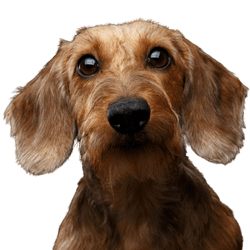
Miniature Dachshund Breed description: Character & Co
Miniature Dachshund
Facts & Origin
What is the origin of the Miniature Dachshund?
The Dachshund has been known since the Middle Ages and has its origins in Germany. The breed descended from the Brackes. From different Bracke types (hunting dogs) there were other dogs bred, which were particularly suitable for hunting underground. From these short-legged animals the Dachshund developed, which is considered to be one of the most versatile hunting dog breeds of all. Already in the year 1888 the first Dachshund club for breeders was founded, who got together to define a common standard. The Dachshund has been bred for decades in three different sizes, namely as standard Dachshund, Miniature Dachshund and Rabbit Dachshund, as well as in three different coat variations (long-haired, short-haired, rough-haired).
What are the breed characteristics of the Miniature Dachshund?
The Miniature Dachshund is a German dog breed recognised by the FCI. Assigned to group four and section one, it belongs to the Dachshunds with working test (Standard No. 148).


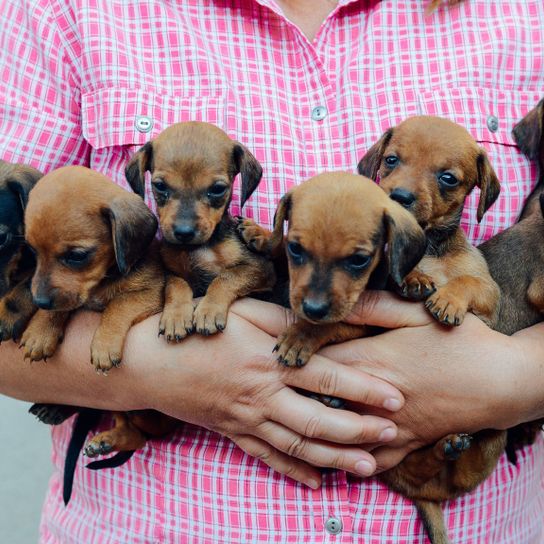

| Alternate Name | - |
| Origin | Germany |
| Life expectancy | 12 - 16 years |
| Care requirements | low-maintenance |
| Activity level | average |
| FCI group | Dachshunds |
| AKC group | Hound Group |
| KC group | Hound Group |
Miniature Dachshund mixes
Attitude, character and temperament of the breed
What are the typical character traits of the Miniature Dachshund?
The Miniature Dachshund has a distinctive self-confidence and a strong temperament, which results in them not showing any fear or aggression. It is characterised by its extremely independent character, but with the right training it gets used to strangers and other environments quickly. Often times they will chose a constant reference person within the family, on whom they concentrate on specifically. Basically the Miniature Dachshund likes to have company. Towards strangers, the little four-legged friend often behaves reserved or distant, but not aggressive. The challenge is to steer the distinctive personality of the Miniature Dachshund in the right direction by using a targeted training approach. The Miniature Dachshund challenges its humans on a daily basis, it has its own will and tries to enforce it constantly. In this aspect it is noticeable that the Dachshund was originally bred as a hunting dog and this self-confidence was and is of benefit to them.
When hunting larger game, such as the badger (hence the name - Dachs in German means badger, Hund means dog), the Dachshund is a sole hunter in the den and must make its own decisions, since the hunter cannot guide them in there. What might seem advantageous while hunting, can make training this little stubborn companion a demanding task. Right from the start, the dog must be led in a consistent manner - yet still lovingly - to make it clear to them who the person in charge is. The Miniature Dachshund is also suitable as a family dog when it is not trained for hunting, as long as it is kept sufficiently occupied.
Character
Usage
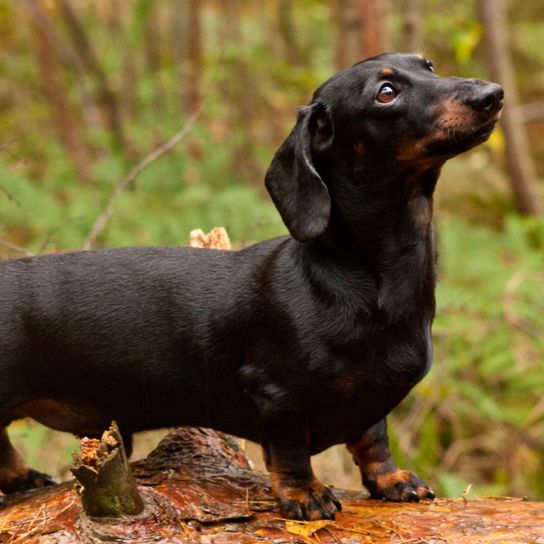
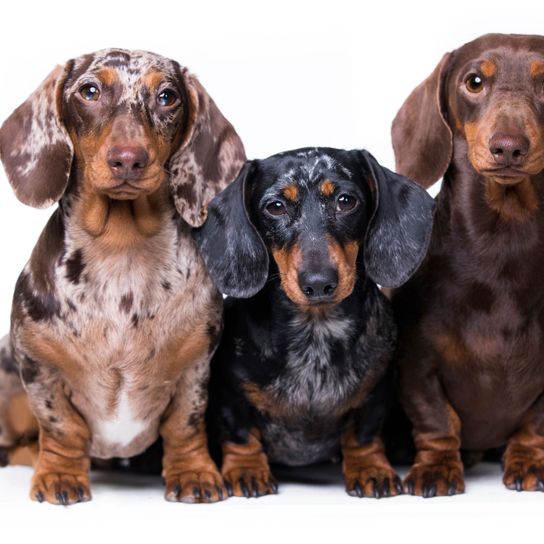

Health and breeding information
What are typical diseases of the Miniature Dachshund?
All in all, the skillful hunting dog is a robust animal. However, the following diseases occur more commonly in this breed:
- Dachshund paralysis (special herniated disc)
- Rheumatism
- Epilepsy
- Disorders of the cardiac valves
What should be considered in regards to Miniature Dachshund breeding?
In breeding, the welfare and health of the parent animals and the Miniature Dachshund puppies is the main focus. Serious breeders let you visit them in their home, where they will show you all of their animals and answer your questions. The Miniature Dachshund puppies should be vaccinated, dewormed several times and chipped. They should have pedigree papers, a vaccination certificate as well as a health certificate.


It is characterised by a short, elongated, low but compact shape. However, it is very muscular and holds its head in an upright, bold and daring position and has an alert expression. The shortened legs of the Dachshund are fixed in the breed standard and are a special feature of this hearty four-legged friend. Despite the short legs, this skillful hunting dog is extremely agile. The drooping ears are rounded at the bottom and rest against the cheeks. The Miniature Dachshund has an extremely good sense of smell, which makes them a reliable companion when hunting. Both above and below ground they follow tracks precisely and search for game tirelessly in the thicket.
Appearance and coat of the Miniature Dachshund
The small four-legged friend with its characteristic long body and short legs is bred in several different variations. If you decide to buy a Miniature Dachshund, you should inform yourself about the different characteristics of the breed. The Miniature Dachshund is found in the following coat variations:
- Short-haired Miniature Dachshund
- Rough-haired Miniature Dachshund
- Long-haired Miniature Dachshund
With the different breeding lines there are certain requirements for the coat as well as regarding colour variations permitted. For the short-haired Miniature Dachshund the following applies:
- short, dense, shiny coat
- firm and hard
- slick against the body
- red, red-yellow or yellow with or without black markings
- two-coloured in black or brown with rust-brown or yellow markings
- black, red or grey with black or grey spots (no plates)
The following standard is set for the rough-haired Miniature Dachshund:
- evenly close-fitting coat
- undercoated
- thick and wiry top coat
- light to dark and dry foliage colours
- the same colours described for the short-haired type are also permitted
The long-haired Miniature Dachshund must fulfill the following criteria:
- plain and shiny
- tight fitting to the body
- underneath the neck and on the underside of the body it gets longer
- it is longest on the underside of the tail, where it forms a complete flag
- the colours are identical to the short-haired variation
| Short-haired Dachshund | Rough-haired Dachshund | Long-haired Dachshund |
|
close-fitting against the body |
interspersed with an undercoat |
plain and shiny |
|
black, red or grey with black or grey spots (no plates) |
the colours described for the short-haired type are also permitted |
longest at the bottom of the rod, forming a complete flag |
What is the average size of a Miniature Dachshund?
According to the breed standard, a Miniature Dachshund has a chest circumference of 30 to 35 centimetres. The withers height is 20 to 26 centimetres.
How much does a Miniature Dachshund weigh?
A Miniature Dachshund weighs about four kilograms.
What is the life expectancy of a Miniature Dachshund?
The average life expectancy of a Miniature Dachshund is 12 to 15 years.
| Fur length | short |
| Fur | flat coated |
| Ear shape | Triangle |
| Tail | short |
| Anatomy | strong |
| Size ♀ | 20 - 35 cm |
| Weight ♀ | 4 - 5 kg |
| Size ♂ | 20 - 35 cm |
| Weight ♂ | 4 - 5 kg |
| Suitable For | Seniors |
Colors









Known Diseases
Dachshund Paralysis
By dachshund paralysis (discopathy) veterinarians mean paralysis of the limbs in dogs.
Epilepsy
Definition: Dog has epilepsy if, for example, at least two epileptic seizures occur more than 24 hours apart.
Heart disease
Can occur frequently in dogs and can sometimes be treated with medication.
rheumatic diseases
Fever, severely swollen joints and lameness can indicate rheumatism in dogs
Other small dogs
Useful Articles
You can find articles that might interest you in the dogbible blog to match your favorite breed.
Visit our magazineto stay up to date on dog trends.
To find out more, view our Privacy Policy
Matching your favorite breed, you'll find articles that might interest you on the dogbible dog blog.
Perfect city dogs: These are the breeds you should get if you live in a big city
How much does a vet visit cost for a dog?
Lyme disease in dogs - symptoms & treatment and why its so dangerous







